The Internet of Things on AWS – Official Blog
Connected Factory Solution based on AWS IoT for Industry 4.0 success
Manufacturing industries only realize 20 to 30 percent of the value of their data. By consistently leveraging the value of their data, manufacturing companies could reduce product development costs by up to 50 percent and operating costs by up to 25 percent, while increasing their gross margins by one third[1]. Industrial IoT (IIoT) is a data lever – it brings machines, field assets at the edge, cloud computing, analytics, and people together to improve the performance and productivity of industrial processes. With IIoT, industrial companies can digitize processes, transform business models, and improve performance and productivity, while decreasing waste. Currently, companies across a wide range of industries are working on IoT projects that connect billions of devices and deliver value across a variety of use cases including predictive quality and maintenance analytics, asset condition monitoring, and process optimization.
For example, Volkswagen Group is partnering with AWS to improve the productivity of their plants and save billions of euros when data from all 124 Volkswagen Group plants can be evaluated in a standardized way – “The Industrial Cloud will be a key lever for improving the productivity of plants by 30 percent” according to Head of Volkswagen Group Production Gerd Walker.[2]
Introducing the AWS IoT Connected Factory Solution
The AWS IoT Connected Factory Solution makes it easy for customers to modernize their operations. With two versions of the solution, AWS can address the needs of manufacturing customers no matter their size or level of maturity along their Industry 4.0 transformation journey. The solution includes an industrial machine connectivity (IMC) kit, a kit to help customers easily get data from their assets into the AWS Cloud, IIoT Consulting and deployment expertise from AWS Professional Services, global and regional system integrators, and partner solutions based on AWS IoT for Industry 4.0 use cases.
Unlock data to modernize manufacturing
We see that a vast majority of industrial customers are seeking a solution that can free up operational data at scale with near real-time visibility. This data visibility, through dashboards and deeper analytics like ML/AI, helps customers understand the reasons for production micro-stoppages, improve throughput without compromising quality, and understand trends that lead to sub-optimal quality parts being manufactured. Additionally, customers are looking for data visibility at enterprise, plant, line, machine, process, and product level which is not possible today with data being locked within these plants.
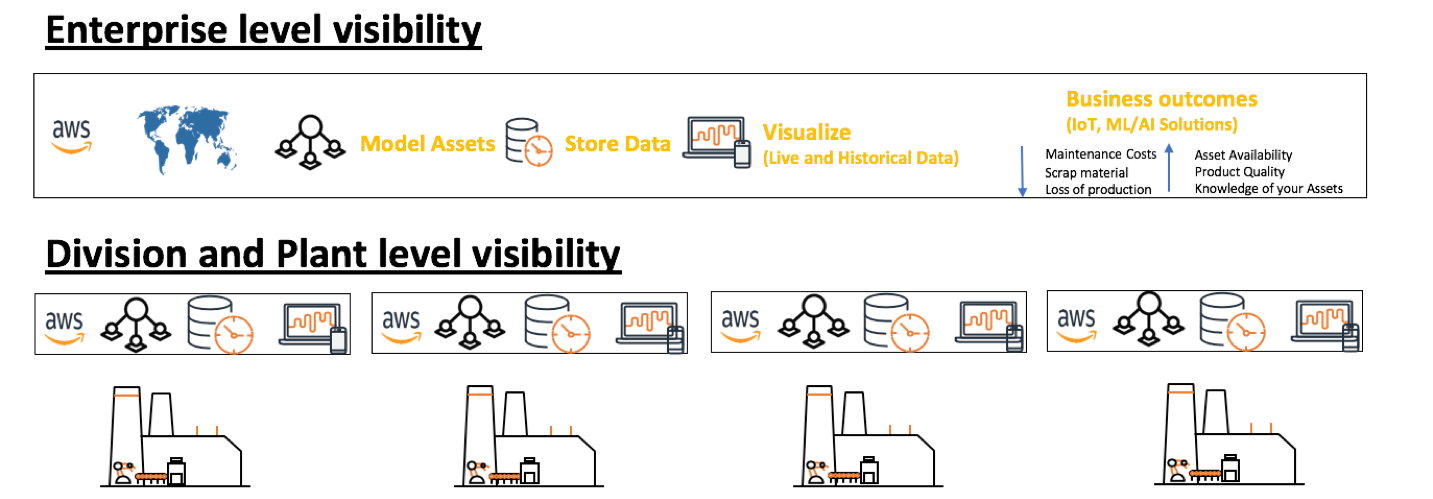
Manufacturing Challenges
The biggest manufacturing challenges are visibility into operational technology (OT) data from machines, such as Programmable Logic Controllers (PLCs) and Supervisory Control and Data Acquisition (SCADA) systems, for performing Root Cause Analysis (RCA) when a line or machine goes down, improving throughput without compromising quality, and understanding details of micro-stoppages of machinery in real time. Even advanced implementations like a Factory Information Systems (FIS) cannot provide visibility at a component level (e.g. a motor in a machine). The vast majority of industrial customers cannot do any analysis in real time even at the line or machine level, let alone at the component level.
IT Challenges
A manufacturing plant floor has a disparate set of PLCs and multiple device protocols (300+) which make it extremely challenging to talk to these plant floor “Things” and access data which can be leveraged for diagnostics and predictive analytics. Additionally, most customers and partners spend an inordinate amount of time building connectivity to these plant floor systems by linking their IT applications to OT systems which is highly unscalable due to multiple integration points without an IT framework driven approach. Additionally, they have to build technology components to scale solutions from multi-plant rollout, security, and multiple other viewpoints. A key blocker for Industry 4.0 initiatives is this device connectivity and integration challenge limiting scalability.
The Connected Factory Solution
The Connected Factory Solution helps customers get production solutions and proof of value (PoV) deployments running at their plants as quickly as possible. First, with this solution customers do not have to invest significantly in data collection that is considered undifferentiated heavy lifting. Second, customers are able to collect, organize, and store their industrial data in AWS in an operational data store for hot data, data that is accessed frequently, and an industrial date lake for warm/cold data, data that is infrequently accessed, as well as define virtual assets and asset hierarchies to provide structure and context to the data. Third, with this streamlined data collection process, customers are able to recognize immediate business value through visualization of their operational metrics from all sources of data. Fourth, they receive a deployment kit to be able to roll out the solution across all their factory lines and plants. Lastly, with this data organized in AWS, customers can accelerate their Industry 4.0 journey and achieve business outcomes like predictive maintenance, predictive quality, and remote asset management.

The Connected Factory Solution is available in two versions. Customers can select the Mobilize for Production Offering from AWS Professional Services or the Proof of Value Offering from the AWS GSI/SI Partner Network. The architecture for both versions is shown below.
Connected Factory Option 1: Mobilize for Production Offering from AWS Professional Services
Below is the Connected Factory Solution Architecture for Real-Time Data that is delivered during the Mobilize for Production Offering from AWS Professional Services.
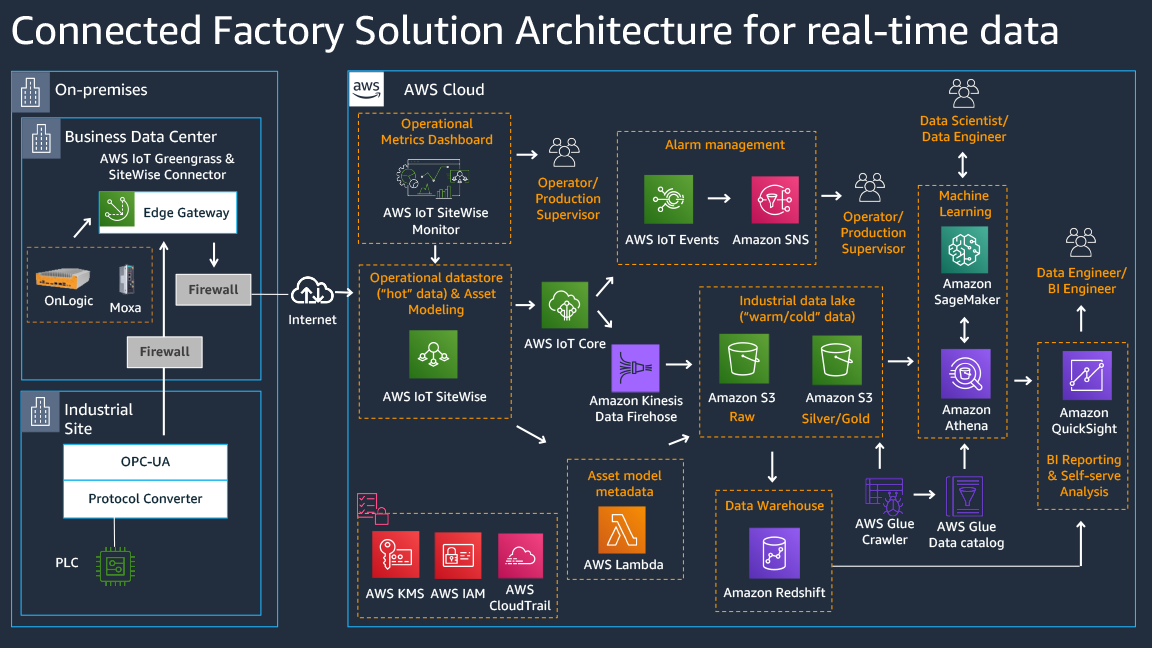
Connected Factory Option 2: Proof of Value Offering from the AWS GSI/SI Partner Network
The IMC kit is designed to enable customers and partners to get data from their assets into the AWS Cloud in a simple, structured process so they can rapidly realize the business value that is derived from that data. Customers can convert existing asset hierarchy definitions (i.e. factory, lines, machines, tags, etc.) defined in partner edge applications like Inductive Automation’s Ignition Server or PTC’s KEPServerEX to the equivalent asset hierarchy within AWS IoT SiteWise. With asset hierarchies defined within AWS IoT SiteWise, customer data can be ingested continuously into the AWS Cloud and all the pertinent metadata is readily accessible for applications to help customers uncover business value, such as developing more efficient maintenance schedules from asset condition monitoring dashboards. Below is the reference architecture for the IMC kit, with Partner Connectivity Applications from Ignition and Kepware shown as 2 options for industrial protocol translation at the edge.
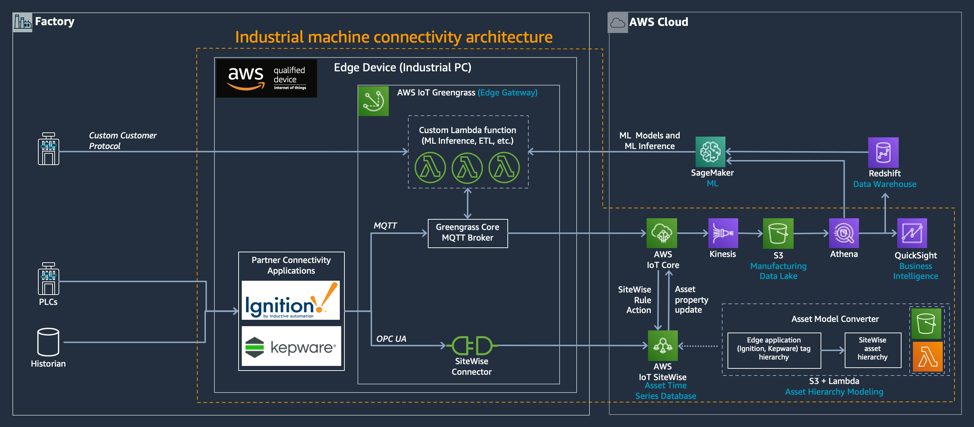
With multiple ingestion patterns from the edge to the cloud, customers and partners may choose the IMC Kit path that suits the needs of their specific use case. The first ingestion path is via the AWS IoT SiteWise Connector running in an AWS IoT Greengrass core (via OPC-UA) to AWS IoT SiteWise in the cloud. The second ingestion path is sending data directly from edge applications (i.e. Ignition Server) to AWS IoT Core via MQTT. The third ingestion path is sending data from the edge application (i.e. Ignition Server or KEPServerEX) to AWS IoT Greengrass where it can then be processed and filtered by customer-defined AWS Lambda functions, used for local machine learning model inference or consumed by a containerized Docker application. Raw and processed data can then be transmitted to the AWS Cloud through a number of different paths including AWS IoT Core, Amazon Kinesis Data Streams, or AWS IoT Analytics. No matter the data ingestion path from edge to cloud, the IMC kit supports the mapping of the edge application asset tag hierarchy into AWS IoT SiteWise so that the asset meta data is always available in the cloud for applications to use.
Configuration and deployment process
The IMC kit will include the hardware and software required to connect a customer’s equipment to the cloud and visualize their data. The kit is designed to enable partners to see real business value from the IIoT solution and deploy a complete production solution that addresses all of their critical use cases. One example of a proof of value deployment a partner could deliver would be to help enable a customer to visualize near real-time operational metrics and perform Root Cause Analysis (RCA) of their assets when a line goes down. The kit software will be packaged into CloudFormation Templates that simplify the deployment process. There are two deployment modes: virtual (for evaluation and training) and physical (for real deployments). The CloudFormation Templates will provision the cloud resources and generate the scripts required to bootstrap physical edge devices. All documentation required to deploy this kit will be included with the CloudFormation Templates. The CloudFormation Stacks that will launch resources in AWS IoT SiteWise, AWS IoT Greengrass, AWS IoT Core, AWS Lambda, Amazon DynamoDB, AWS CloudFormation, Amazon EC2, Amazon S3, and Amazon QuickSight. Below is a map of how the IMC kit components relate to ISA 95 levels and what capabilities are enabled at each level.
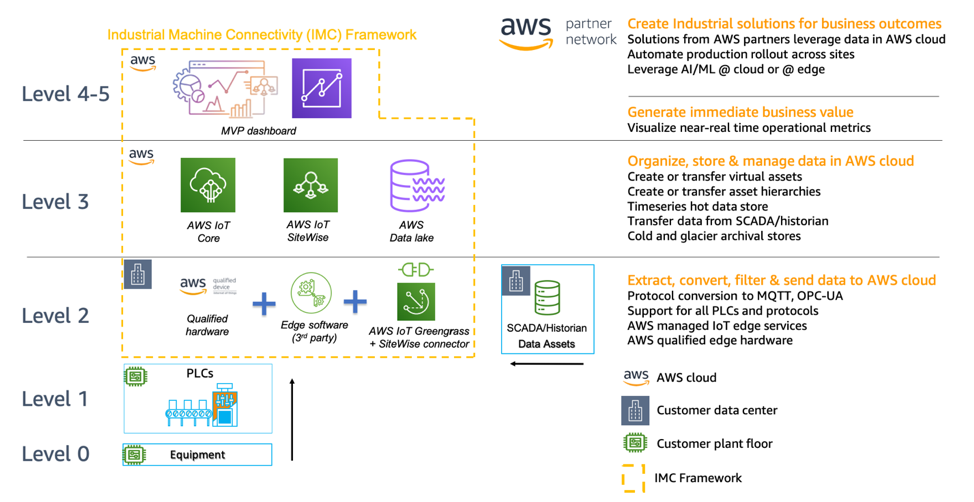
Extending the IMC Kit with Partner Solution Integrations
The IMC kit has been designed to enable partners to integrate with their own products and solutions. For example, an independent software vendor (ISV) that markets an industrial protocol adapter software application may want to integrate with the IMC kit to simplify the process of building IIoT solutions on top of AWS IoT services. The source code for the IMC kit is public so partners and customers can have access to the entire code repository and documentation. SI and GSI partners are trained to integrate their solution portfolio with the IMC kit, so that the industrial machine connectivity component of their architecture is simplified.
IIoT Consulting and Deployment Expertise with the AWS Partner Ecosystem
More and more enterprise companies are modernizing their manufacturing operations with AWS. While every company is different, and some will feel comfortable to tackle these challenges on their own, most of the companies we work with are looking for help. Some companies lack deep knowledge with the AWS platform to design the right architecture, don’t have enough resources to implement it, lack the technological breadth to integrate with all their enterprise systems, need help to create engaging user interfaces and experience, or are not staffed to operate their solution globally around the clock.
The Connected Factory Solution brings an ecosystem of partners across hardware, edge software, IIoT consulting, deployment, and industrial solutions that can help customers build and implement applications. Partners are important in this transformation – AWS continues to build an ecosystem of complimentary capabilities to accelerate business outcomes for customers. The ecosystem of partners shown in the image below has the expertise to deliver an end-to-end solution for customers to reduce the complexity of IIoT. These partners leverage the IMC kit so they can focus on differentiation instead of the infrastructure needed for their IIoT solutions. This minimizes risk, reduces development costs, and drives unique value differentiation.
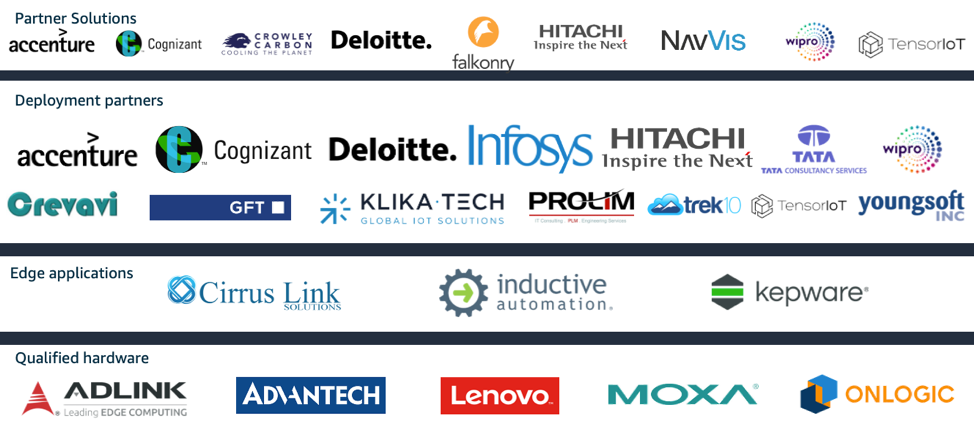
Summary
The Connected Factory Solution accelerates our customers’ journey to optimize operations, reduce the infrastructure heavy lifting, and unlock the value trapped in their data. With this solution, customers get a consistent AWS IoT experience and are able to unlock data to modernize their manufacturing operations and accelerate Industry 4.0 success.
You can start using the Connected Factory Solution right away using the source code in the Github repository, or contact the AWS IoT team to learn more about this solution and how you can use it to transform your manufacturing operations.
[1] https://www.mckinsey.com/business-functions/operations/our-insights/manufacturing-analytics-unleashes-productivity-and-profitability
[2] https://media.vw.com/releases/1303